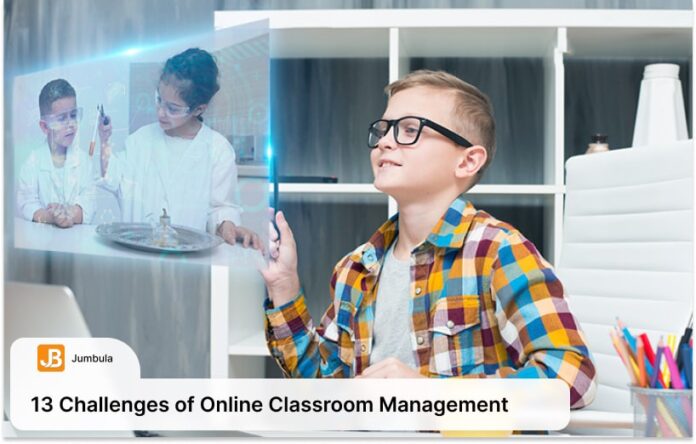Amidst the Covid-19 pandemic, the education industry faced unprecedented challenges and sought innovative solutions to ensure continuity. The advent of virtual classes emerged as a response to address the challenges of online classroom management.
Today, online courses have become an indispensable component of the education system, offering students the flexibility they desire while pursuing their studies. However, this rapid transition has also intensified the existing challenges of online class management, presenting a myriad of new issues for school administrators, educators, parents, and students to navigate.
Challenges of online class management
These new problems can sometimes be frustrating and hard to overcome. In order to get past these issues, we should fully understand them and learn how to deal with them.
Sometimes the performance of teachers, students, and parents can be affected by these issues, and they suffer by not knowing how to overcome the problems. Therefore, in the following, we shall explore the most significant common problems in classroom management we are facing today.
Internet issues
No one can deny that virtual classrooms offer an appealing opportunity for the educational community to reach out to each other from the comfort of their homes. But on the other hand, connectivity issues are persistent and inseparable challenges for educators and students.
Not all people have access to stable and efficient internet connections to have quality classes because many students live in areas with poor or unreliable connections. The Internet is the core requirement of virtual classrooms, so low bandwidth connection can pose a severe challenge.
Technical issues
With the rising of the virtual classes era, a new item list has been added to students’ school supplies. In order to succeed in an online classroom, students need a computer, laptop, or Chromebook. They also need access to a reliable internet connection.
Although the Internet is now more accessible than ever, students can encounter various issues related to connectivity. Video, audio, and other materials can be challenging to download. Access to a high-speed internet connection is a common problem for some students.

They also need to know where to get technical support in case of connectivity problems or other problems and have a basic knowledge of computer science. With adequate computer training, many students learn how to operate essential computer functions or deal with technical issues.
External distractions
Learning from home is a fantastic experience.
You might have access to everything you need, like a refrigerator full of snacks, and be present at school with a pajama. But everything comes with a price. At home, there is countless distractions factor that students struggle with. From siblings, parents, pets, cell phones, and other devices to a lack of designated quiet workspace. Students will have to overcome family stresses alongside the pressure of the educational system.
Related Article: 6 Reasons Why Games Enhance Classroom Learning
And in the educator’s perspective, keeping students engaged and focused in a physical classroom is challenging, and this is amplified further in the virtual setting. Teachers need to be able to walk around classrooms to see if students are engaged in their tasks or distracted by a video game or a clip on social media.
These common problems can be frustrating and devastating when combined with other issues for students and teachers.
Teachers feel unsupported
Learning new ways of communication and figuring out technology can sometimes be intimidating and overwhelming to educators because it can affect the overall class performance. In fact, according to Promethean research, only 5% of educators believe that they have training and support with educational technology in schools.
There are countless benefits in adopting new technology in education, from ensuring students are on the right page (literally, if on a screen) to the ability to analyze data and quickly identify where students may be struggling.
To feel more confident using technology, they need a straightforward and structured training system to help them fully understand these new techs. Some schools also organize regular support groups where teachers can share tips and advice.
The need for parent collaboration
Online learning sometimes changes parents’ lifestyles. Kids spend most of their time at home, so parents must take a far more hands-on approach to their child’s education. They may have to provide the tools children need, like printing materials or buying different colored pens, and maintain a quiet learning environment. Parents need to be supported with even just some small pointers during this time, as many will be working from home themselves.
Lack of motivation among students
Online learning would be the new interactive and immersive way to teach the new generation of students. However, the results suggest otherwise. Endless oceans of texts, quizzes, and frequent learning tasks have left students needing more motivation to visit the learning portal again and again.
Students complain about a lack of motivation due to the lack of interpersonal contact between students and instructors in online courses. Physical interaction between students is also required to maintain engagement, for which online learning methodology has yet to give an answer. Institutions must provide interactive instruction to students.
Ensuring internet safety for students
Safety and security are significant and joint issues. It is essential to safeguard students’ online classes and ensure they use technology devices and the Internet correctly. IT administrators should look for a quick, easy, and effective way to ensure students are unable to access inappropriate or harmful content online. It is also essential to secure devices from online threats.
Leaving teenagers alone in this vast digital lifestyle is not a good and wise decision that requires cooperative actions from parents, experts, and school staff to create a healthy environment.

Monitoring & maintenance from the cloud
Online learning demands a great need for computer technology, adequate software, constant electricity, and high-bandwidth Internet. Although this large amount of investing in these devices will have its benefits, it comes with some problems.
The process of manually maintaining devices and ensuring they are kept up-to-date, and lesson-ready is challenging. Teachers and students constantly encounter problematic devices during classes, so they need assistance. Monitoring and maintenance remotely from the cloud are essential for teachers.
Unique educational requirements
Inclusive education is vital for ensuring that all students, including those with learning difficulties or disabilities, can thrive in online classes. Students with conditions such as dyslexia, autism, visual impairment, hearing loss, and others may require additional support to achieve academic success. While physical classrooms have traditionally provided more personalized attention for these students, there are solutions to make online learning more accessible and inclusive for everyone.

As a teacher, it’s crucial to assess the accessibility of your online course and make necessary improvements to accommodate all learners. Here are some effective strategies to enhance usability:
- Caption audio and video resources: By providing captions, students with hearing impairments can fully engage with the content. This ensures equal access to the information conveyed through multimedia materials.
- Incorporate voice-over descriptions: Adding voice-over descriptions for text and images helps students with visual impairments to understand and interpret the course materials effectively.
- Offer alternative learning options: Consider implementing features such as keyboard shortcuts for exercises, enabling students with specific needs to navigate the course more efficiently. This allows them to interact with the content in a way that suits their learning style or physical capabilities.
- Utilize AI-powered personal assistants: Leveraging artificial intelligence (AI) technology can provide personalized assistance to students with special needs. AI-powered personal assistants can offer real-time support, adapt the learning experience based on individual requirements, and help overcome barriers to comprehension or participation.
Related Article: Benefits of an Online Registration Systems
Students struggling with isolation
Isolation is not easy for anyone to cope with. It can be easy to get frustrated due to the lack of human contact, the inability to raise concerns immediately, the absence of a teacher, only remote learning from online teaching, and a failure to discuss problems with classmates.
Children in virtual learning classes may sometime feel cut off from their friends. One solution for resolving these problems is fostering personal interaction within the online course as much as possible. For example, you can organize webinars, group work, or forums where students can discuss and resolve their queries.
Teachers and students have fewer academic discussions and collaborative learning opportunities without careful planning. They also have fewer opportunities for informal interactions.
Online learning challenges – Learning styles
Students and all learners have learning styles and are accustomed to physical classrooms. But online learning can create a challenging and different type of learning. Not all students can quickly adapt to these new styles, and they will face difficult situations. The problem will be in such cases as lack of concentration, inability to understand the live classes, and difficulty creating projects and assignments using technology.
This lack of concentration is not a behavior management problem new to the virtual classroom. However, it is a problem that is heightened in the virtual classroom. Teachers develop routines and behavior management plans in a regular classroom to minimize distractions and maximize learning. Accordingly, students expect these plans, and their focus sometimes relies on them. This is why the distraction rate is so high in online classes.
Feedback issue during online class
The physical presence inside a classroom with a teacher and fellow peers often leads to an atmosphere that can’t be replicated through virtual means. One important aspect is that every learner needs feedback on their performance and assignment during the learning process to enhance their learning ability and productivity.
Researches show that student barely visits their work to check their educator feedback and guidelines. For better results, teachers should give personalized guidance for improvement for every student and identify their weaknesses and strengths. But when this task is combined with online classes can be problematic.

Difficulty managing time
Time management is a beneficial skill that we all use every day. But this skill is not easy, and it must be taught. Participating in the physical classroom promotes time management skills for most students.
But in a virtual classroom, though, procrastination becomes much easier. Once again, distraction becomes a big issue, and it affects every aspect of learning. Teachers and parents have less supervision in virtual classrooms, which means accountability is limited for students. Communication barriers are another reason students may not know what’s expected unless a teacher explicitly says everything to students. They don’t know how much time to spend on an assignment is reasonable. Again, educators must provide these expectations and the skills they must teach.
There are a few methods that can affect your concentration over some time. These are some of them:
Avoid distractions
Stay away from distractions that can distract you from your learning. Many platforms can engage you for entertainment and communication. But make sure that you set time for breaks and focus on learning as scheduled to avoid missing live classes or sessions.
Create To-Do list
Every day, prepare a list of tasks you need to accomplish. Try to break down extensive activities into smaller ones for better learning outcomes. As you tackle each task, refer to this list. Follow the list and establish a routine that makes time management easy.
Seek help
Ask your parents, friends, and family for help managing your time during online learning. So that you will not miss out on education and, at the same time, work will be done.
Avoid multitasking
Do not try to take up multiple tasks simultaneously. Complete one task at a time, as it can make your work less effective and productive.
How to deal with these problems in classroom management?
These challenges of online classroom management are only a few that many students face during remote education. The sudden switch to online classes and online learning has caused anxiety and raised questions among students about their academic futures.
But where there is a problem, there is always a solution.
Related Article: Best Class Registration Software in 2023
Final Word
While the challenges of online class management are diverse, they can be tackled with compassion, creativity, and flexibility. To navigate these obstacles smoothly, access to essential resources is crucial. These resources encompass professional development programs and behavior management software.
It’s important to recognize that online education brings significant advantages, such as making education more affordable and accessible to a wider audience. By embracing these opportunities and leveraging the right tools, we can overcome the challenges and pave the way for a more effective and inclusive learning experience.
When these challenges create problems in classroom management, Jumbula offers a comprehensive solution. Jumbula understands the intricacies of online classroom management and has developed features specifically designed to address these challenges.
With Jumbula, educators can streamline administrative tasks, such as scheduling classes, managing attendance, and organizing assignments. The platform also provides behavior management tools to ensure a productive and focused learning environment.

